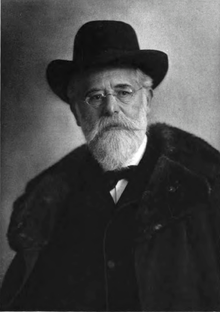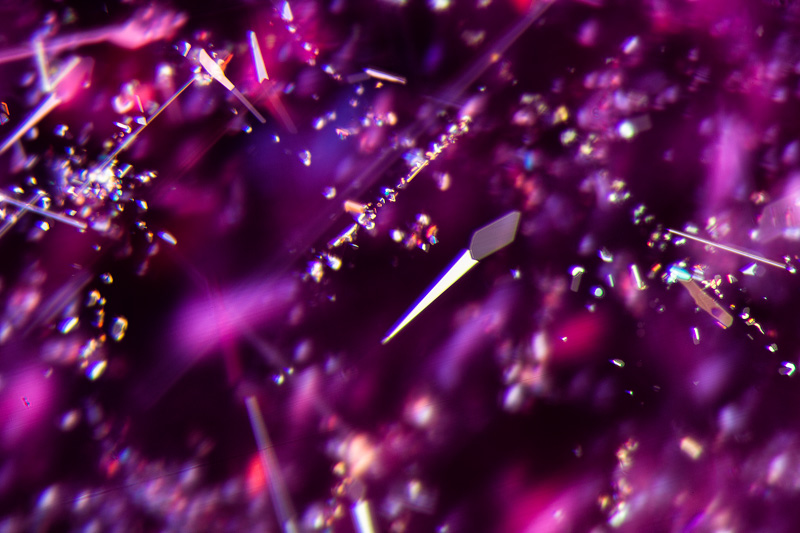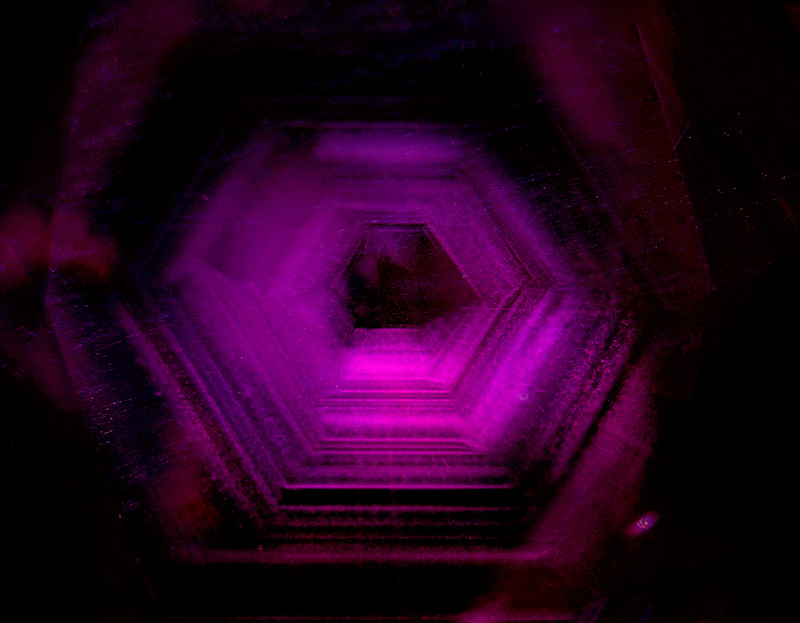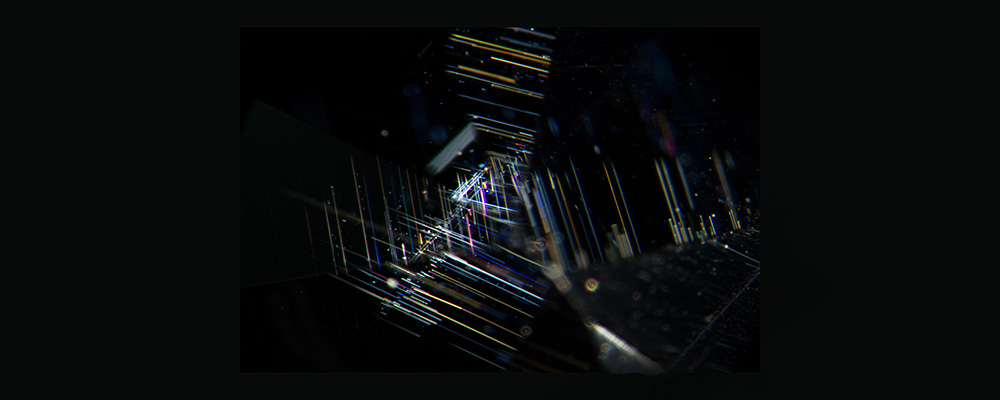In 1878, the noted Austrian mineralogist, Gustav Tschermak von Seysenegg [1836–1927], was the first to properly identify silk in corundum, finding it to be composed of the mineral rutile (TiO2). An English translation of his landmark paper is included, along with the original German version.
 Gustav Tschermak von Seysenegg, who first identified silk as exsolved rutile in corundum.
Gustav Tschermak von Seysenegg, who first identified silk as exsolved rutile in corundum.
A PDF of the original paper can be downloaded by clicking on the icon below:
XXIII. Optical behavior of corundum crystals
By G. Tschermak
It has been known for a long time that when placed into polarization devices, many plates of corundum display a cross that stands out with a light gray color, and that often opens the cross when turning verifiable. 1)
Mallard has studied corundum crystals, which consist of six sectors, each of which shows the appearance of the Lemniscaten [polar curve] in the arrangement as in a rhombic drilling of individuals. 2)
The small crystals of Ceylon sometimes offer a different appearance. Some of these crystals show in their training a monoclinic symmetry by two withdraw from the three pairs of surfaces, which form the usually occurring rhombohedron, very, while the third pair of faces is very well developed. Such crystals also give the appearance of optically zweiaxigen body very much, and the approximative corresponds to the monoclinic form. The plane of the optic axes is perpendicular to the plane of symmetry of the Axenwinkel was determined on a clear individual with the use of sodium light at 10° 28'. The experiments to determine the angle that forms the first center line with the normal to the end face, gave no useful result because the Endfläch to the used crystals was not sufficiently perfect. The character of the birefringence is negative.
The approximative is therefore the same as in muscovite, the Axenwinkel but significantly smaller. Said more developed area would correspond to a pair Hemidoma, the other two rhomoëderflächen a Hemipyramide from the zone 130: 001; all such decomposed in the same manner as in the biotite the rhombohedron previously adopted in the Hemidoma r and the pyramid z faces up. However, the crystals of this type also have sections as seen through which they appear uniaxial, and although these are usually in the center of the crystal. In parallel polarized light is then seen inside the crystal a fine tangle of particles, as already indicates Mallard, outwardly but the crystal appears quite homogeneous zweiaxig.
 Rutile silk in Ceylon sapphire. Oblique fiber-optic dark-field illumination. Photo: Richard W. Hughes
Rutile silk in Ceylon sapphire. Oblique fiber-optic dark-field illumination. Photo: Richard W. Hughes
In the crystals of Ceylon sapphire are found many inclusions. Some of them are colorless, often rounded, but sometimes elongated. In the latter case, the longitudinal axis is often parallel to a direction which corresponds to the blunting of the edge of the six-sided prism. Sometimes sharply formed negative crystals occur. Other inclusions consist of nice, relatively large tetragonal crystals, which present the combination of prism and pyramid in the same position. After the angles of the pyramid to close the half-metallic appearance and brown color, one may view the crystals of rutile. The longitudinal axes of these crystals are parallel to the horizontal edges of the hexagonal prism.
Furthermore, most show fine brown networks consisting of extremely thin needles parallel to the aforementioned edges. Therefore the needles appear crossed at 60° and woven at these angles, in much the same way as the needle-like inclusions in some phlogopite [mica]. I believe these fine needles are also rutile.
 Rutile silk in ruby from Mozambique, featuring a small daughter crystal of unknown origin at the broad end. Oblique fiber-optic dark-field illumination. Photo: Richard W. Hughes
Rutile silk in ruby from Mozambique, featuring a small daughter crystal of unknown origin at the broad end. Oblique fiber-optic dark-field illumination. Photo: Richard W. Hughes
On the blue corundum of Kischtym in the Urals I found at a low end face a coarse striation, whose lines are perpendicular to the sides of the hexagon, and also between the strips systems irregularly extending boundaries, giving the impression of a Drilingsverwachsung arises. Papers parallel to the end surface decreased, but the appearance shown in the polarization instruments soon faded cross, soon zweiaxiger body, the approximative in each of the three sectors in turn corresponds to the observations in corundum of Ceylon. The fine reticular inclusions were also observed here, however, they are sparse. The layered structure of the crystals is expressed by the sequence of concentric hexagons of different colors.
 Clouds of rutile silk in Mozambique ruby, forming concentric hexagonal zones when viewed parallel to the c axis.
Clouds of rutile silk in Mozambique ruby, forming concentric hexagonal zones when viewed parallel to the c axis.
Photo: Wimon Manorotkul
The corundum of Barsoweka in the Urals shows uncommonly beautiful changes between the blue and colorless layers. The blue layers in places are irregularly interrupted by a colorless substance. Under the microscope shows switching zweiaxiger particles between the uniaxial. The zweiaxigen are visually as well as in the aforementioned orientation in corundum and their location corresponds THEREFORE turn a regular intergrowth in three different positions by 120°. The blue layers appear to have a greater Axenwinkel than the colorless.
Aue communicated that optical observations could be concluded that some corundum crystals are composed partly of zweiaxigen particles. For the latter, a monoclinic crystal system was assumed as in general a rhombohedral crystal, the one imagines composed of particles smaller degree of symmetry, initially can only consist of mono-symmetric particles.
Some observations that were made on corundum, may be in connection with the aforementioned phenomena. The shell composition parallel to the rhombohedron, which often gives the impression of cleavage and is also considered for shows up more often merely after two faces of the rhombohedron, but not after the third. The fine striations on the end face of some crystals corresponds to monosymmetric burrows.
The sometimes occurring shell composition parallel to the end face would suggest that those particles are sometimes observed in the mica Zwillingsverwachsung connected to each other by leaves follow each other, which are always oriented offset by 120 °.
Footnotes
- 1) Comp. Descloizeaux. Nouvelles recherches, p. 12, etc.
[Descloiseaux, Alfred (1867) Nouvelles Recherches sur les Proprietes Optiques des Cristaux] - 2) Explication des phénomènes optique anomaux etc. 1877
[Mallard, François-Ernest (1877) Explication des phénomènes optiques anomaux que présentent un grand nombre de substances cristallisées]

About the author
Gustav Tschermak von Seysenegg (19 April 1836 – 24 May 1927) was an Austrian mineralogist, who did much work on minerals and meteorites. The mineral tschermakite is named in his honor. In 1871 he established the Mineralogische Mitteilungen (Mineralogical Reports), published after 1878 as the Mineralogische und petrographische Mitteilungen (Mineralogical and Petrographical Reports).
Further reading
- Koivula & Hughes (2005) Following the Silk Road: Rutile in Corundum.
- Koivula, J.I. & Hughes, R.W. (2005) Living in the Dark Ages: The Fiber-Optic Light.
Notes
Many thanks to Elise Skalwold for her assistance, not just in locating this document, but also for assisting with so many other paper chases.

XXIII. Optisches Verhalten von Korund-Krystallen.
Von G. Tschermak.
Es ist schon längere Zeit bekannt, dass viele Platten von Korund im Polarisations-Apparate ein Kreuz geben, welches durch eine hellgraue Farbe auffällt, und dass häufig das Kreuz beim Drehen eich öffnet. 1)
Mallard hat Korund-Krystalle untersucht, welche aus sechs Sectoren bestehen, deren jeder die Erscheinung der Lemniscaten in der Anordnung wie in einem Drilling aus rhombischen Individuen zeigt. 2)
Die kleinen Krystalle von Ceylon bieten zuweilen eine andere Erscheinung. Manche dieser Krystalle zeigen in ihrer Ausbildung eine monokline Symmetrie, indem von den drei Flächenpaaren, welche das gewöhnlich auftretende Rhomboëder bilden, zwei sehr zurücktreten, während das dritte Flächenpaar sehr stark entwickelt ist. Solche Krystalle geben auch die Erscheinung der optisch zweiaxigen Körper sehr deutlich, und die Orientirung entspricht der monoklinen Form. Die Ebene der optischen Axen ist senkrecht zur Symmetrieebene, der Axenwinkel wurde an einem klaren Individuum bei Anwendung von Natriumlicht zu 10° 28' bestimmt. Die Versuche, den Winkel zu bestimmen, welchen die erste Mittellinie mit der Normalen auf die Endfläche bildet, gaben kein brauchbares Resultat, weil die Endfläch an den benutzten Krystallen nicht hinreichend vollkommen war. Der Charakter der Doppelbrechung ist negativ.
Die Orientirung ist also dieselbe wie beim Muscovit, der Axenwinkel ist aber bedeutend kleiner. Das genannte stärker entwickelte Flächenpaar entspräche einem Hemidoma, die beiden anderen Rhomoëderflächen einer Hemipyramide aus der Zone 130: 001; alles in derselben Weise, wie bei dem Biotit das früher angenommene Rhomboëder in das Hemidoma r und die Pyramidenflächen z sich zerlegt. Die Krystalle dieser Art haben aber auch Stellen, durch welche gesehen sie einaxig erscheinen, und zwar liegen diese gewöhnlich in der Mitte des Krystalls. Im parallelen polarisirten Lichte erkennt man dann im Inneren des Krystalls ein feines Gewirre von Theilchen, wie dies schon Mallard angibt, nach aussen hin aber erscheint der Krystall ziemlich homogen zweiaxig.
In den Krystallen von Ceylon stecken viele Einschlüsse. Die einen davon sind farblos, öfters rundlich, zuweilen aber in die Länge gezogen. In diesem Falle ist die Längsaxe oft parallel einer Richtung, welche der Abstumpfung der Kante des sechsseitigen Prisma entspricht. Manchmal kommen scharf ausgebildete negative Krystalle vor. Andere Einschlüsse bestehen aus netten, relativ grossen tetragonalen Krystallen, welche die Combination von Prisma und Pyramide gleicher Stellung darbieten. Nach den Winkeln der Pyramide, dem halbmetallischen Aussehen und der braunen Farbe zu schliessen, darf man die Krystalle als Rutil ansehen. Die Längsaxen dieser Krystalle sind den horizontalen Kanten des sechsseitigen Prisma parallel.
Ferner zeigen sich höchst feine braune Netze, aus ungemein dünnen Nadeln bestehend, welche gleichfalls den eben genannten Kanten parallel sind. Die Nadeln erscheinen demnach unter Winkeln von 60° gekreuzt und durcheinander gewoben; in ganz ähnlicher Weise wie die nadelförmigen Einschlüsse in manchen Phlogopiten. Ich möchte diese feinen Nadeln gleichfalls für Rutil halten.
An dem blauen Korund von Kischtym im Ural fand ich an einem Exemplare auf der Endfläche eine grobe Streifung, deren Linien senkrecht zu den Seiten des Sechseckes liegen, ferner zwischen den Streifensystemen unregelmässig verlaufende Grenzen, so dass der Eindruck einer Drilingsverwachsung entsteht. Blättchen parallel der Endfläche abgenommen, zeigen im Polarisationsinstrumente bald ein verwaschenes Kreuz, bald aber die Erscheinung zweiaxiger Körper, die Orientirung in jedem der drei Sectoren entspricht wiederum der am Korund von Ceylon beobachteten. Die feinen netzartigen Einschlüsse wurden auch hier beobachtet, sie sind jedoch spärlich. Der schichtenförmige Aufbau der Krystalle ist durch die Folge concentriecher Sechsecke von verschiedener Färbung ausgesprochen.
Der Korund von Barsoweka im Ural zeigt den Wechsel der blauen und farblosen Schichten ungemein schön. Die blauen Schichten sind aber stellenweise unregelmässig von farbloser Substanz unterbrochen. Unter dem Mikroskop zeigt sich eine Einschaltung zweiaxiger Partikel zwischen den einaxigen. Die zweiaxigen sind optisch ebenso orientirt wie in dem vorgenannten Korund und ihre Lage entspricht sonach wiederum einer regelmässigen Verwachsung in drei um je 120° verschiedenen Stellungen. Die blauen Schichten scheinen einen grösseren Axenwinkel zu haben als die farblosen.
Aue den mitgetheilten optischen Beobachtungen könnte man schliessen , dass manche Korund-Krystalle zum Theil aus zweiaxigen Partikeln zusammengesetzt sind. Für die letzteren wäre ein monoklines Krystallsystem anzunehmen, wie denn überhaupt ein rhomboëdrischer Krystall, den man sich aus Theilchen geringeren Symmetriegrades aufgebaut denkt, zunächst nur aus monosymmetrischen Partikeln bestehen kann.
Manche Wahrnehmungen, die am Korund gemacht wurden, stehen vielleicht im Zusammenhange mit den genannten Erscheinungen. Die schalige Zusammensetzung parallel den Rhomboëderflächen, welche öfters den Eindruck der Spaltbarkeit macht und auch dafür angesehen wird, zeigt sich öfter blos nach zwei Flächen des Rhomboëders, nicht aber nach der dritten. Auch die feine Streifung auf der Endfläche mancher Krystalle entspricht einem monosymmetrischen Baue.
Die zuweilen auftretende schalige Zusammensetzung parallel der Endfläche würde darauf deuten, dass jene Partikelchen zuweilen in der beim Glimmer beobachteten Zwillingsverwachsung mit einander verbunden sind, indem Blättchen über einander folgen, welche immer um je 120° verschieden orientirt sind.
1) Vergl. Descloizeaux. Nouvelles recherches, pag. 12 etc.
2) Explication des phénomènes optique anomaux etc. 1877.





